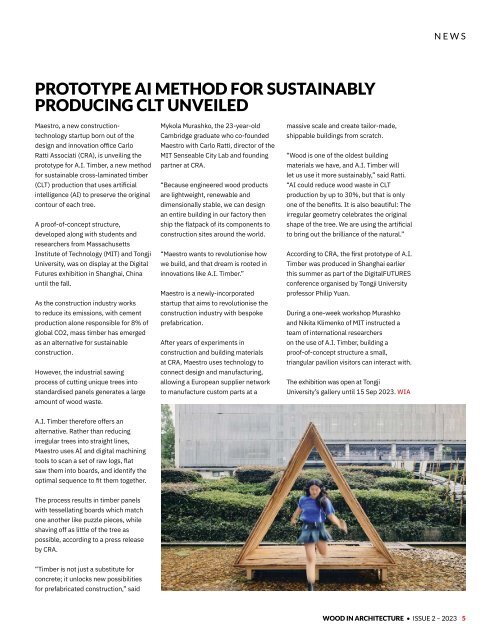WIA_ISSUE2_2023
You also want an ePaper? Increase the reach of your titles
YUMPU automatically turns print PDFs into web optimized ePapers that Google loves.
NEWS<br />
PROTOTYPE AI METHOD FOR SUSTAINABLY<br />
PRODUCING CLT UNVEILED<br />
Maestro, a new constructiontechnology<br />
startup born out of the<br />
design and innovation office Carlo<br />
Ratti Associati (CRA), is unveiling the<br />
prototype for A.I. Timber, a new method<br />
for sustainable cross-laminated timber<br />
(CLT) production that uses artificial<br />
intelligence (AI) to preserve the original<br />
contour of each tree.<br />
A proof-of-concept structure,<br />
developed along with students and<br />
researchers from Massachusetts<br />
Institute of Technology (MIT) and Tongji<br />
University, was on display at the Digital<br />
Futures exhibition in Shanghai, China<br />
until the fall.<br />
As the construction industry works<br />
to reduce its emissions, with cement<br />
production alone responsible for 8% of<br />
global CO2, mass timber has emerged<br />
as an alternative for sustainable<br />
construction.<br />
However, the industrial sawing<br />
process of cutting unique trees into<br />
standardised panels generates a large<br />
amount of wood waste.<br />
Mykola Murashko, the 23-year-old<br />
Cambridge graduate who co-founded<br />
Maestro with Carlo Ratti, director of the<br />
MIT Senseable City Lab and founding<br />
partner at CRA.<br />
“Because engineered wood products<br />
are lightweight, renewable and<br />
dimensionally stable, we can design<br />
an entire building in our factory then<br />
ship the flatpack of its components to<br />
construction sites around the world.<br />
“Maestro wants to revolutionise how<br />
we build, and that dream is rooted in<br />
innovations like A.I. Timber.”<br />
Maestro is a newly-incorporated<br />
startup that aims to revolutionise the<br />
construction industry with bespoke<br />
prefabrication.<br />
After years of experiments in<br />
construction and building materials<br />
at CRA, Maestro uses technology to<br />
connect design and manufacturing,<br />
allowing a European supplier network<br />
to manufacture custom parts at a<br />
massive scale and create tailor-made,<br />
shippable buildings from scratch.<br />
“Wood is one of the oldest building<br />
materials we have, and A.I. Timber will<br />
let us use it more sustainably,” said Ratti.<br />
“AI could reduce wood waste in CLT<br />
production by up to 30%, but that is only<br />
one of the benefits. It is also beautiful: The<br />
irregular geometry celebrates the original<br />
shape of the tree. We are using the artificial<br />
to bring out the brilliance of the natural.”<br />
According to CRA, the first prototype of A.I.<br />
Timber was produced in Shanghai earlier<br />
this summer as part of the DigitalFUTURES<br />
conference organised by Tongji University<br />
professor Philip Yuan.<br />
During a one-week workshop Murashko<br />
and Nikita Klimenko of MIT instructed a<br />
team of international researchers<br />
on the use of A.I. Timber, building a<br />
proof-of-concept structure a small,<br />
triangular pavilion visitors can interact with.<br />
The exhibition was open at Tongji<br />
University’s gallery until 15 Sep <strong>2023</strong>. <strong>WIA</strong><br />
A.I. Timber therefore offers an<br />
alternative. Rather than reducing<br />
irregular trees into straight lines,<br />
Maestro uses AI and digital machining<br />
tools to scan a set of raw logs, flat<br />
saw them into boards, and identify the<br />
optimal sequence to fit them together.<br />
The process results in timber panels<br />
with tessellating boards which match<br />
one another like puzzle pieces, while<br />
shaving off as little of the tree as<br />
possible, according to a press release<br />
by CRA.<br />
“Timber is not just a substitute for<br />
concrete; it unlocks new possibilities<br />
for prefabricated construction,” said<br />
WOOD IN ARCHITECTURE • ISSUE 2 – <strong>2023</strong> 5

















